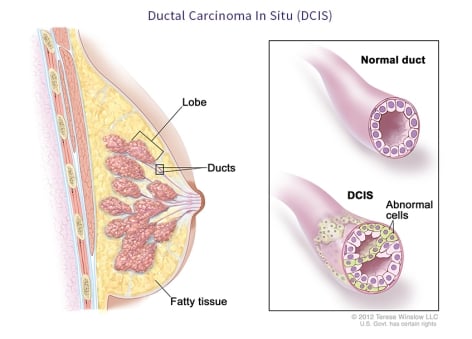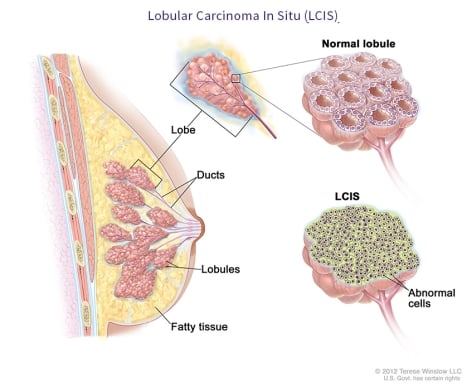Types of Breast Cancer
As part of the breast cancer diagnosis process, your medical team will identify the specific type of breast cancer you have. This is done by thoroughly testing the tissue sample collected from your breast biopsy or the tumor itself after breast cancer surgery.
The type of breast cancer is determined by the specific characteristics of the cells in the breast that have become cancerous. Most breast cancers are adenocarcinomas, which means the cancer first developed in the breast’s milk ducts or milk-producing glands.
Once breast cancer is identified, several other categories are defined for each patient. Together, this information impacts which treatments will work best for you.
Invasive vs. Noninvasive Breast Cancer
There are two primary categories of breast cancer: invasive and noninvasive. Invasive (infiltrating) breast cancer refers to cancer that has spread to surrounding tissues. Noninvasive (in situ) breast cancer means the cancerous cells are still confined to their point of origin. Usually only found on a mammogram, noninvasive breast cancer is typically very early stage.
Common Types of Breast Cancer
Invasive Breast Cancer Types
Invasive ductal carcinoma
Invasive ductal carcinoma (IDC), accounting for 80% of breast cancers, indicates cancer cells started in the lining of the breast milk duct and have invaded surrounding tissue. Over time, invasive ductal carcinoma can spread to the lymph nodes and possibly to other areas of the body.
Invasive lobular carcinoma
Invasive lobular carcinoma (ILC) starts in the milk-producing glands (lobules) and can spread to other parts of the body. It is the second most common form of invasive breast cancer, accounting for 10 to 15% of breast cancer cases.
Invasive breast cancers require an oncology team to treat the cancer by creating an individualized plan using one or more of the following breast cancer treatment options:
- Surgery
- Radiation therapy
- Hormone therapy for hormone-positive breast cancers
- Targeted therapy for HER2-positive breast cancers and other genetic changes
- Immunotherapy
The treatment plan will also depend on the stage of breast cancer the oncologist establishes.
Types of Non-Invasive Breast Cancer
Ductal carcinoma in situ
Ductal carcinoma in situ (DCIS) is non-invasive breast cancer in the lining of the breast milk duct. DCIS isn’t considered life-threatening. However, treatment may be necessary so it doesn’t continue to grow into invasive breast cancer.

Lobular carcinoma in situ
Lobular carcinoma in situ (LCIS) is also sometimes called lobular neoplasia. Though the name can be confusing, LCIS is not considered a cancer or a pre-cancer because it doesn’t turn into invasive cancer if untreated. Instead, LCIS is an indication that a person is at a higher risk of getting breast cancer later on.

Less Common Types of Breast Cancer
Triple-Negative Breast Cancer
About 15% of invasive breast cancers are considered triple-negative. This type of breast cancer does not have receptors for estrogen, progesterone, and HER2. Since hormones do not contribute to the growth of this type of breast cancer, treatment for triple-negative breast cancer is different from other types of breast cancer.
Inflammatory Breast Cancer
A less common type of breast cancer, accounting for 1-3% of all breast cancers, is inflammatory breast cancer (IBC). IBC often appears to be an infection (breast red, swollen, and inflamed), because cancer blocks lymphatic vessels in the skin and breast tissue, causing a buildup of fluid (lymph). Read our blog to learn more about inflammatory breast cancer.
Other Rare Types of Breast Cancer
- Paget disease of the nipple: A rare type of breast cancer that starts in the milk ducts and spreads to the skin of the nipple and areola. It accounts for only about 1% of all breast cancer cases.
- Phyllodes tumor: Another type of rare breast tumor that develops in the connective tissue of the breast. They grow in a leaf-like pattern and tend to grow quickly but rarely spread outside the breast.
- Angiosarcoma: A type of cancer that develops in the inner lining of blood vessels. Although it can occur in any part of the body, it is rare in the breast.
Breast Cancer Care in Hampton Roads and Eastern North Carolina
If you have been newly diagnosed with breast cancer, the VOA breast cancer specialists are here to develop a personalized breast cancer treatment plan for you. Request an appointment at our cancer centers located across Hampton Roads and Eastern North Carolina, including Virginia Beach, Norfolk, Hampton, Williamsburg, Chesapeake, Suffolk (Harbour View and Obici), Newport News, VA, and Elizabeth City, NC.




